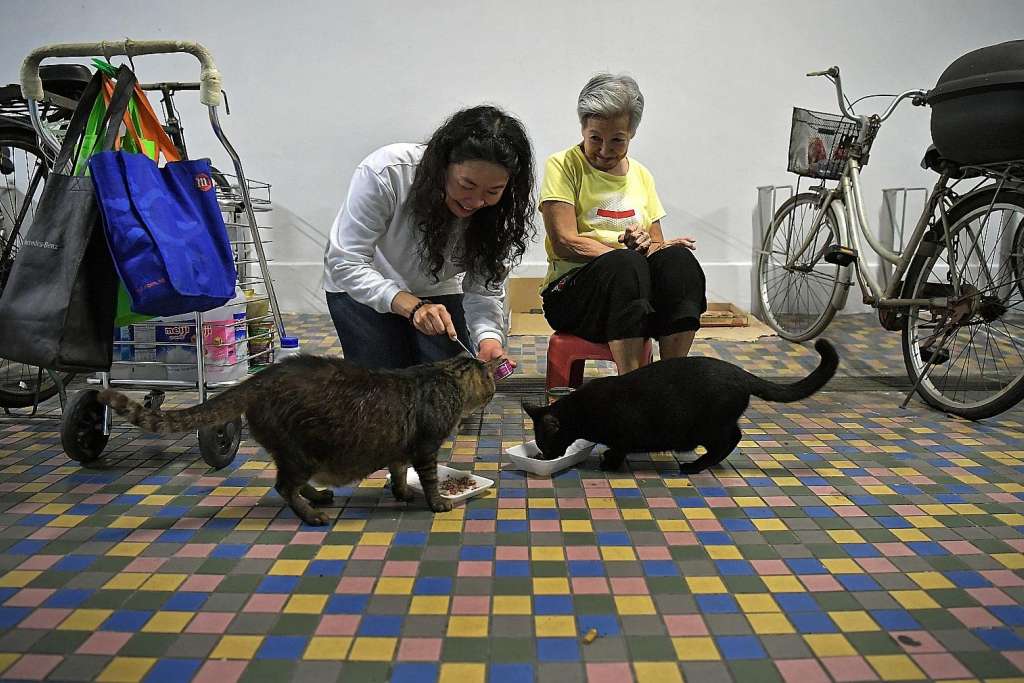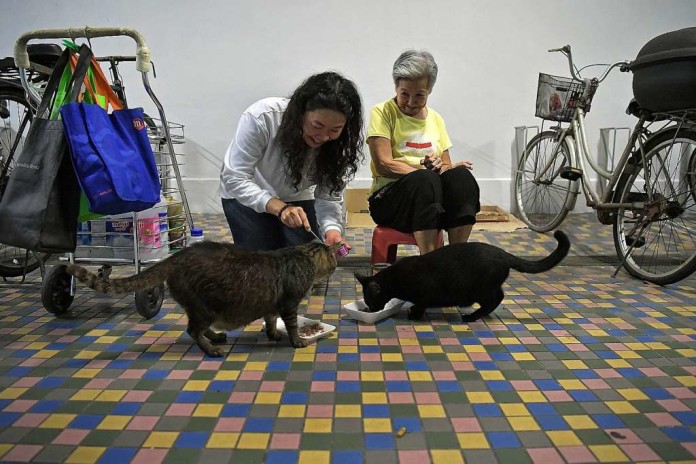Every day for the past 20 years, Madam Nancy Koh has been feeding the stray cats in her Beach Road estate, paying for the food out of her own pocket.
But this Christmas, the 77-year- old retiree is one of 47 so-called stray feeders who will get supplies of pet food from a donation drive during the festive season of giving.
Strays are decreasing in numbers with sterilisation, rehoming and culling efforts, but there are still tens of thousands of them, tugging at the heartstrings of animal lovers.
Administrative assistant Shirley Tan, 42, started the annual Christmas donation drive in 2013, inspired by another group that had pooled their bonuses to buy food for strays and animals in shelters.
The stray feeders who benefit are aged 40 to 80, mostly women. They include retirees, civil servants and real estate agents.
“I see myself as a facilitator of sorts, bringing the donors and the beneficiaries together,” said Ms Tan. “This is something everyone can do.”
She has garnered almost $9,500 in donations this year, reaching her goal of feeding about 4,500 animals from Christmas until the start of the new year by campaigning through Facebook and telephone.
The donations are a relief for Madam Koh, who lives alone and spends $200 to $400 a month on food for about 25 stray cats.
Between 2am and 5am every day, she can be found feeding the animals and cleaning up after the cats.
She chooses that time of day so it does not cause a nuisance to members of the public.
“It all started when a cat kept turning up on my sofa every evening after work,” said Madam Koh.
“I tried to shoo it away but it kept coming back. I changed my mind and began to give it food. The more I fed, the more they came.”
When a cat she fed for 16 years died three years ago, she cried for several months.
Once she took a sick animal to the vet, which cost her $1,200 as it had to be hospitalised for a week.
Human resource manager Desiree Lim, 36, and her family donated about $600 to Ms Tan’s cause this year.
“I love animals and enjoy helping them. It can be very demoralising if you’re trying and trying and nobody supports you,” she said.
Most of the money goes to buying canned pet food, which is mixed in with kibbles – dry pellets of cat or dog food – or rice.
“Once they get used to you, they’ll wait for you at the same time same place, rain or shine,” said Ms Tan.
But not everyone approves of stray feeding. Retiree Ong Lian Choon, 60, who lives in Lorong 1 Toa Payoh, said: “They just put the food there and leave it. The leftovers have attracted flies and rats… and I’m allergic to cat fur.”
She said there is an elderly woman who frequents the area with a pushcart.
The woman, unlike Madam Koh, leaves the packets of food for the strays she encounters but does not clean up after them.
This has caused problems. In 2014, the authorities blamed the Bukit Batok rat infestation on food left behind by stray feeders.
Strays can also threaten people. In October, the Agri-Food and Veterinary Authority (AVA) installed cameras in Yishun after people complained of being chased by a pack of stray dogs.
Mr Ricky Yeo, president of animal welfare organisation Action for Singapore Dogs, said responsible stray feeders who clean up after feeding could play an important role in helping strays – especially dogs – be less aggressive towards humans.
The feeders could also make efforts to sterilise strays easier.
“The stray feeders are actually our eyes and ears on the ground, and they are the connection to the dogs.
It takes months, sometimes years, of feeding to get the dogs’ trust,” Mr Yeo said.
The Ministry of National Development and AVA are also working with animal welfare groups to rehome stray dogs.
One of their initiatives, Project Adore, was started in 2011 and rehomed 469 dogs in Housing Board flats as of last month.

This article was first published on December 20, 2016.
Get a copy of The Straits Times or go to straitstimes.com for more stories.







